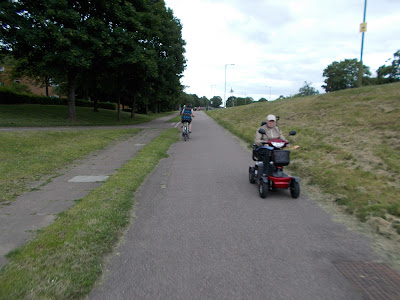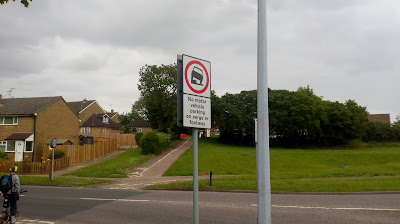In my last post, I recounted a recent cycling safari which started in Hatfield and I left you with as close to a cliffhanger as I can get with kerbs at the edge of Welwyn Garden City. This post completes the journey which ended up in the New Town of Stevenage.
To recap, then. The cliffhanger was the entrance to an underpass;
To be precise, this is the junction of the A1000 Chequers/ Howlands/ Chequersfield which to those driving is nothing particularly exciting. For those walking and cycling, it's something a little unusual. The roads approaching the roundabout ramp up which means that the ramp down into the underpass isn't as steep as it might otherwise be and so keeps everything compact (relatively speaking);
The centre of the roundabout is open to the sky and the visibility through the tunnels is good (no 90° turns at a subway wall here). What is noticeable is the age of the infrastructure. This has been around a long time with the faded red cycle tracks, small clumps of weeds at the edge of the paving and not quite 100% perfect accessibility for pedestrians. However, what this also says is the original design and construction was pretty much bullet-proof. Let's take a quick ride through;
We carried on our journey along the shared-use cycle track next to the A1000 and skirting the centre of Welwyn Garden City. The provision was back to the usual UK sharing with toucan crossings and giving way at side roads and it was clear that the highway network was there for mass driving, not active travel. The underpass seemed to be very incongruous compared with everything else.
We eventually headed through a residential area where NCN12 was signed and on into Sherradspark Wood where we ended up on an unsurfaced track. It was pleasant enough, but a leisure route rather than useful for daily transport. We crossed the A1(M) on a bridge into Ayot Green which was marked as a "Quiet Lane".
It was actually very quiet for a while as we passed through the countryside skirting Codicote and on towards Old Knebworth (still following NCN12). This was pure leisure cycling and great fun it was too.
We managed to take in some serious hills (compared to what we were usually used to) which was interesting given the type of bikes we had (2 folders and a 3 gear upright). Eventually, we reached the edge of Stevenage and after dicing with maniac drivers on Old Knebworth Lane we were directed onto a truly terrible traffic-free link which you can see at the end of this video;
So we had arrived in Stevenage. I am not even going to try and explain how the town was designed and laid out and there's no need as others have written about it such as Carlton Reid in this in-depth article. The short version is that my new local engineering hero, Eric Claxton, was the chief engineer of the multi-disciplinary team who designed and built the New Town.
What we have in Stevenage is a network of "cycleways" (Claxton's name for them) which are completely separate from the main road network. Alex, Hester and I rode around these cycleways for a couple of hours with barely an interaction with motor traffic. Like the Welwyn Garden City underpass above, Claxton's network is jaded, but long lived and certainly, maintenance and upgrade works take place;
To cycle round in comfort and safety was wonderful, but there was something not quite right. We had lunch in the town centre and like Hatfield, cycling is banned (although this was sensibly being ignored);
The town centre is very smart given its age and it functions well as a pedestrian precinct. From a cycling point of view, none of the cycleway network actually takes you into the town centre and so you are back mixing with motor traffic. We also got off the main cycleways and ventured into an industrial area and into some of the residential areas;
The older parts of the town had spurs from the cycleways, but the newer areas didn't and within a few metres we could have been anywhere in the UK, although there was some attempt to keep the cars off the footways;
The trouble with Stevenage is that in terms of active travel, it is unfinished. The cycleways are the same as when they were built with little evidence of expansion into the residential and commercial/ industrial areas. The protection quickly fizzles out in many residential areas and the town centre is actively hostile to cycling. The town is also sprawling and in many respects it still takes quite a long time to get around by bike (you wouldn't bother on foot for most of it).
There is also a highly developed and accessible motoring network which means that it is easy to get around by car. Many parts of the cycling network felt like a long slog to use between any place of interest.
There is some interesting data in the Hertfordshire County Travel Survey for Stevenage (2015);
The area has a 4% mode share for cycling to work which is just above Hertfordshire's 3% mode share (the UK average is 2%), but it also has a whopping 71% mode share for driving to work (that's driver) compared to 59% for the county. For school travel, cycling is lumped in with "other" for the town with 45% of school journeys being made by car;
This is all against a backdrop of the town having more people without access to a car than the county average.
These are just a few facts, but I think they help to show that despite the cycleway network, Stevenage is firmly a car town within which it is easy to drive.
I'll leave you with a video of some of the cycleway network as I think we can relearn a great deal of the engineering - but we also need the realise that this needs to properly connect people to their homes, jobs and town centres. We can also learn a great deal about the town planning because many mistakes were made in Stevenage.
What we have in Stevenage is a network of "cycleways" (Claxton's name for them) which are completely separate from the main road network. Alex, Hester and I rode around these cycleways for a couple of hours with barely an interaction with motor traffic. Like the Welwyn Garden City underpass above, Claxton's network is jaded, but long lived and certainly, maintenance and upgrade works take place;
To cycle round in comfort and safety was wonderful, but there was something not quite right. We had lunch in the town centre and like Hatfield, cycling is banned (although this was sensibly being ignored);
The town centre is very smart given its age and it functions well as a pedestrian precinct. From a cycling point of view, none of the cycleway network actually takes you into the town centre and so you are back mixing with motor traffic. We also got off the main cycleways and ventured into an industrial area and into some of the residential areas;
The older parts of the town had spurs from the cycleways, but the newer areas didn't and within a few metres we could have been anywhere in the UK, although there was some attempt to keep the cars off the footways;
The trouble with Stevenage is that in terms of active travel, it is unfinished. The cycleways are the same as when they were built with little evidence of expansion into the residential and commercial/ industrial areas. The protection quickly fizzles out in many residential areas and the town centre is actively hostile to cycling. The town is also sprawling and in many respects it still takes quite a long time to get around by bike (you wouldn't bother on foot for most of it).
There is also a highly developed and accessible motoring network which means that it is easy to get around by car. Many parts of the cycling network felt like a long slog to use between any place of interest.
There is some interesting data in the Hertfordshire County Travel Survey for Stevenage (2015);
The area has a 4% mode share for cycling to work which is just above Hertfordshire's 3% mode share (the UK average is 2%), but it also has a whopping 71% mode share for driving to work (that's driver) compared to 59% for the county. For school travel, cycling is lumped in with "other" for the town with 45% of school journeys being made by car;
This is all against a backdrop of the town having more people without access to a car than the county average.
These are just a few facts, but I think they help to show that despite the cycleway network, Stevenage is firmly a car town within which it is easy to drive.
I'll leave you with a video of some of the cycleway network as I think we can relearn a great deal of the engineering - but we also need the realise that this needs to properly connect people to their homes, jobs and town centres. We can also learn a great deal about the town planning because many mistakes were made in Stevenage.






























Possibly similar to arrnagement in Bracknell. Good cycle ways, but not always easy to connect to roads. The council provide good cycling maps but I often get lost because the street names are the car end of turnings etc.
ReplyDeleteYeah, it's almost "there" but not quite.
ReplyDeleteThat underpass is pretty nice.
It just goes to show that people who actually cycle as their usual mode of transportation should be giving feedback about design to the engineers. Otherwise you have people who don't cycle or don't cycle for everyday usage and while likely well intentioned, just can't fully relate.
Do cities in the U.K. have things like advisory councils? They have them in some Canadian cities. City plans get run by them to see if they work for a particular type of person or activity. (Seniors, handicapped, cycling, walking, etc.)
The subway in Welwyn Garden City described above is I assume a Stevenage type junction built when WGC was doing some development in the 1960s. There are similar subways at Mundels under the gyratory system and an accessible but cut off one under the Welwyn bypass which looks like it was cut off by the A1(M) being built. It could be reopened very easily.
ReplyDeleteSadly from the 1960ds until the late 1990s not a lot happened. In the early 2000s we had lots of new cycle paths in the Hatfield Business Park but not connected to the railway station, despite this being a promise when the business park opened!
The other issue in Welwyn Hatfield is the lack of connectivity to neighbouring towns, the routes all being for leisure use only and unusable for all year commuting as isolated and unlit.
WelHatCycling continues to lobby when we can.
Cheers
Adam
It is tough to campaign when those in power don't seem to grasp how active travel could transform a town.
Delete